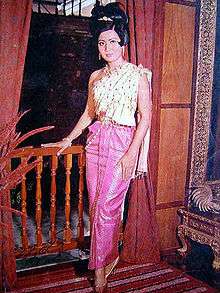Petchara Chaowarat
| Petchara Chaowarat | |
|---|---|
 Iconic Thai leading lady of the 1960 and '70s. | |
| Born |
Ek Chaowarat[1] January 19, 1943 Rayong, Thailand |
Petchara Chaowarat (Thai: เพชรา เชาวราษฎร์, born January 19, 1943, in Rayong Province, Thailand) is a Thai film actress who starred in around 300 films from 1961 to 1979. An icon of the "Golden Age" of Thai cinema, she was known for her round, pool-like eyes and elaborate hairstyles.[2]
Her first film and starring role was in Banthuk Rak Pimchawee (Love Diary of Pimchawee), in 1961. She co-starred with popular leading man, Mitr Chaibancha, and they proved to be popular pair, starring together in more than 150 films.
One of their most popular films was 1970's Monrak luk thung (Thai: มนต์รักลูกทุ่ง, or Magical Love of the Countryside), a musical rhapsodizing Thai rural life.
In 1964, Petchara was named best actress by the Thailand National Film Awards committee for her role in Nok Noi, and received the award from the hands of King Bhumibol.
After Mitr's accidental death on the set of Insee tong in 1970, Petchara continued to act in films.
She starred in the 1971 musical comedy Ai Tui (Mr. Tui), in which she co-starred with Sombat Metanee, who became a popular leading man after Mitr's death. Her last film was Ai Khuntong, which was released in 1979.
Her public appearances have dwindled over the years, attributed to her near blindness,[3] thought to have been caused from her many hours of working in front of the bright lights on film sets.[2]
In 2004, performance artist Michael Shaowanasai co-directed and starred in the film, The Adventure of Iron Pussy, in which he portrayed a transvestite secret agent. The character's hairstyle, clothing and demeanor were based on Petchara. The film was co-directed by Apichatpong Weerasethakul.
More Petchara homage came in 2005, with the film Yam Yasothon (Hello Yasothon), a musical-comedy directed by comedian-actor Petchtai Wongkamlao that was set in the 1960s and captured much of the colorful spirit of the Mitr-Petchara era.
References
- ↑ 30ปีแห่งความหลัง"เพชรา เชาวราษฎร์" (Press release) (in Thai). Komchadluek. Retrieved 16 May 2012.
- 1 2 A star is reborn–Petchara Chaowarat returns to the spotlight after a 30-year hiatus, 27 October 2009, The Bangkok Post
- ↑ The fame game–Ten heroes and villains who riveted the nation this year, 4 December 2009, The Bangkok Post
- Tupchai, Suchada (2005) Adoring fans remember famous Thai film star Mitr Chiabancha Pattaya Mail. Retrieved December 23, 2005.
- Rithdee, Kong (2005) Fallen idols Bangkok Post. Retrieved December 23, 2005.
- Fleshman, Erich (2005) A Brief History of Thai Cinema Notes from Hollywood. Retrieved December 23, 2005.
- Saenkhum, Tanita (2003) Remembering Mitr The Nation. Retrieved December 23, 2005.
- Federation of National Film Association of Thailand (2004) Thai Movie Industry News. Retrieved December 23, 2005.